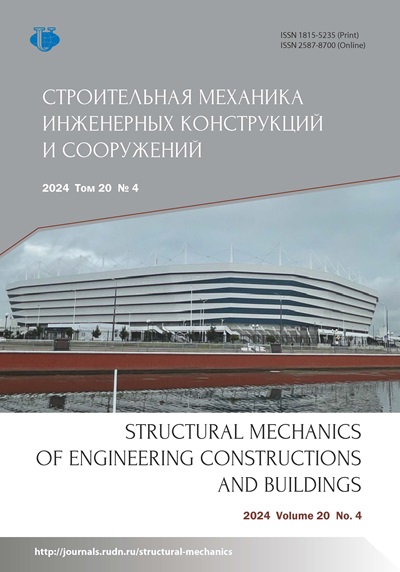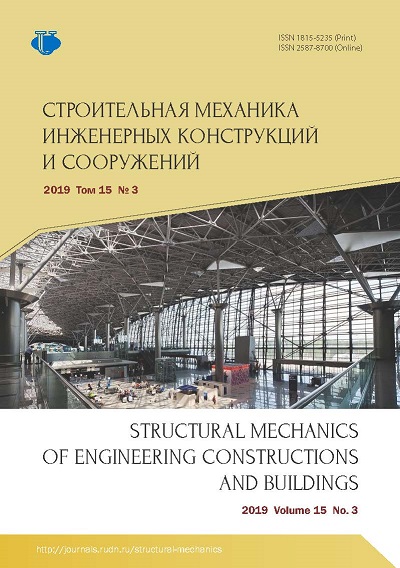Метод полной дискретизации в совместном расчете во времени системы «конструкция - фундамент - грунт»
- Авторы: Тер-Эммануильян Т.Н.1, Полумордвинов И.О.2
-
Учреждения:
- Российский университет транспорта
- Казахстанско-Британский технический университет
- Выпуск: Том 15, № 3 (2019)
- Страницы: 171-181
- Раздел: Расчет и проектирование строительных конструкций
- URL: https://journals.rudn.ru/structural-mechanics/article/view/21409
- DOI: https://doi.org/10.22363/1815-5235-2019-15-3-171-181
Цитировать
Полный текст
Аннотация
Цели исследования. Перспективный переход СНГ на европейские стандарты проектирования в строительной отрасли требует разработки новых и модификации известных инженерных методов расчета и проектирования строительства. Создание и развитие таких методов должно основываться на фундаментальных исследованиях, которые могут стать основой для разработки принципиально новых, инновационных технологий. Методы. В статье рассматриваются основы метода полной дискретизации и его практическое применение. Этот метод является специальной модификацией метода конечных элементов для решения задач ползучести. Практическое применение метода иллюстрируется моделированием и прикладными задачами. Результаты. В работе представлен совместный расчет системы «конструкция - фундамент - грунт» на примере резервуара модульной станции биологической очистки сточных вод, проектируемой для полей фильтрации в поселке Тасбогет Акмолинской области Республики Казахстан. Во всей расчетной области получена полная картина эволюции векторов перемещений, деформаций и напряжений во времени с учетом технологии возведения, проведено сравнение результатов расчета с учетом и без учета технологии возведения конструкций.
Об авторах
Татьяна Николаевна Тер-Эммануильян
Российский университет транспорта
Автор, ответственный за переписку.
Email: tanya_ter@mail.ru
доктор технических наук, доцент, профессор, кафедра «Теоретическая механика»
Российская Федерация, 127994, Москва, ул. Образцова, д. 9, стр. 9Игорь Олегович Полумордвинов
Казахстанско-Британский технический университет
Email: tanya_ter@mail.ru
доктор технических наук, доцент, ассистентпрофессор, факультет «Энергетика и нефтегазовая индустрия.
Республика Казахстан, A05H1T2, Алма-Ата, ул. Толе-би, 59Список литературы
- Chiorino M.A. Analysis of structural effects of timedependent behavior of concrete: an internationally harmonized format // Concrete and Reinforced concrete - Glance at Future: plenary papers of III All Russian (International) Conference on Concrete and Reinforced Concrete, Moscow, 2014. Vol. 7. Pp. 338-350.
- FIB. Model Code for Concrete Structures 2010. Ernst & Sohn, 2013. 402 p.
- Ползучесть и усадка бетона и железобетонных конструкций: cостояние проблемы и перспективы развития / ГОССТРОЙ СССР; НИИЖБ. М.: Стройиздат, 1976. 351 c.
- Беглов А.Д., Санжаровский Р.С., Бондаренко В.М. Ползучесть бетона и модели Евростандартов // Бетон и железобетон. 2005. № 2. C. 29-30.
- Bazant Z.P., Cedolin L. Stability of Structures: Elastic, Inelastic, Fracture and Damage Theories // World Scientific. 2010. 1009.
- Mahnken R.A. Newton-multigrid algorithm for elastoplastic-viscoplastic problems // Comput. Mech. 1995. Vol. 15. Pp. 408-425.
- McTavich D.J., Hughes P.C. Finite element modeling of linear visco-elastic structures: the GHM method // AHS Struct. Dyn. and Mater. Conf., Dallas, TX, 1992. Pp. 1753-1763.
- Mackerle J. Finite elements and boundary elements applied in plane change solidification and melting problems. A bibliography (1996-1998) // Finite Elem. Anal. and Des. 1998. Vol. 32. No. 3. Pp. 203-211.
- Zienkiewich O.C. Visco-plasticity, Plasticity, Creep and Visco-Plastic Flow (Problems of Small, Large and Continuing Deformation) // Lect. Notes Math. 1975. Vol. 461. Pp. 297-328.
- Тер-Эммануильян Н.Я. Метод пространственновременной дискретизации для решения линейных задач теории ползучести: cб. по вопросам математики и механики. Алма-Ата: КазГУ, 1975. № 7. C. 55-61.
- Тер-Эммануильян Н.Я., Тер-Эммануильян Т.Н. Метод полной дискретизации для решения задач упругоползучести. Алма-Ата: Строительство и архитектура, 2006. 416 c.
- Aitalyev Sh., Ter-Emmanuilyan N., Ter-Emmanuilyan T., Shmanov T. Joint calculation of a foundation and soil of the large-scale structure in view of creep. London: Taylor & Francis Group, 2007. Pp. 159-168.
- Aitalyev Sh., Ter-Emmanuilyan T. Method of full discretization in joint calculations of buildings and the bases in view of creep, spatial and time heterogeneity // Questions of applied physics and mathematics, Almaty, 2003. Pp. 241-246.
- Арутюнян Н.Х. Некоторые вопросы теории ползучести. М. - Ленинград: Гостехтеориздат, 1952. 323 c.
- Ilyichev V. Experience of underground construction in Moscow // Works of the international geotechnical conference, Almaty, 2004. Pp. 41-42.
- Александровский С.В. Расчет бетонных и железобетонных конструкций на изменение температуры и влажности с учетом ползучести. М.: Стройиздат, 1973. 432 c.
- Ержанов Ж.С., Каримбаев Т.Д. Метод конечных элементов в задачах механики горных пород. Алма-Ата: Наука, 1975. 238 c.
- Ulitsky V.M., Shashkin A.G., Shashkin K.G., Lisyuk M.B. Soil-structure interaction: methodology of analysis and application in design. Saint Petersburg, Moscow, 2003. 40 p.
- Sanjarovsky R.S., Manchenko M.M. Errors in the theory of creep of reinforced concrete and modern // Строительная механика инженерных конструкций и сооружений. 2016. № 3. C. 25-32.
- Sanjarovskiy R., Ter-Emmanuilyan T., Manchenko M. Creep of Concrete and Its Instant Nonlinear Deformation in the Calculation of Structures // CONCREEP 10. 2015. Рр. 238-247.
- Sanzharovskij R.S., Manchenko M.M. Errors of international standards on reinforced concrete and rules of the Eurocode // Строительная механика инженерных конструкций и сооружений. 2017. № 6. С. 25-36.
- Sanzharovsky R.S., Ter-Emmanuilyan T.N., Manchenko M.M. Superposition principle as the fundamental error of the creep theory and standards of the reinforced concrete // Строительная механика инженерных конструкций и сооружений. 2018. Т. 14. № 2. С. 92-104. http:// dx.doi.org/10.22363/1815-5235-2018-14-2-92-104
- Sanzharovsky R.S., Ter-Emmanuilyan T.N., Manchenko M.M. Three types of errors in the international norms for the design of concrete and reinforced concrete. London: Taylor & Francis Group, 2019
- Овчинников И.Г., Пшеничников М.С. Ползучесть бетона и железобетона: экспериментальные данные, влияние эксплуатационных факторов. Саратов, 1999. 40 с.
















